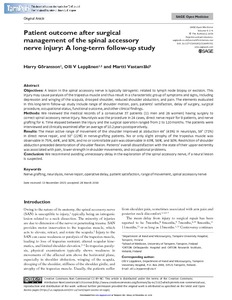Patient outcome after surgical management of the spinal accessory nerve injury: A long-term follow-up study
Göransson, Harry; Leppänen, Olli V; Vastamäki, Martti (2016)
Göransson, Harry
Leppänen, Olli V
Vastamäki, Martti
2016
SAGE Open Medicine 4
Lääketieteen yksikkö - School of Medicine
CC BY-NC-3.0
Julkaisun pysyvä osoite on
https://urn.fi/URN:NBN:fi:uta-201612022727
https://urn.fi/URN:NBN:fi:uta-201612022727
Tiivistelmä
OBJECTIVES:
A lesion in the spinal accessory nerve is typically iatrogenic: related to lymph node biopsy or excision. This injury may cause paralysis of the trapezius muscle and thus result in a characteristic group of symptoms and signs, including depression and winging of the scapula, drooped shoulder, reduced shoulder abduction, and pain. The elements evaluated in this long-term follow-up study include range of shoulder motion, pain, patients' satisfaction, delay of surgery, surgical procedure, occupational status, functional outcome, and other clinical findings.
METHODS:
We reviewed the medical records of a consecutive 37 patients (11 men and 26 women) having surgery to correct spinal accessory nerve injury. Neurolysis was the procedure in 24 cases, direct nerve repair for 9 patients, and nerve grafting for 4. Time elapsed between the injury and the surgical operation ranged from 2 to 120 months. The patients were interviewed and clinically examined after an average of 10.2 years postoperatively.
RESULTS:
The mean active range of movement of the shoulder improved at abduction 44° (43%) in neurolysis, 59° (71%) in direct nerve repair, and 30° (22%) in nerve-grafting patients. No or only slight atrophy of the trapezius muscle was observable in 75%, 44%, and 50%, and no or controllable pain was observable in 63%, 56%, and 50%. Restriction of shoulder abduction preceded deterioration of shoulder flexion. Patients' overall dissatisfaction with the state of their upper extremity was associated with pain, lower strength in shoulder movements, and occupational problems.
A lesion in the spinal accessory nerve is typically iatrogenic: related to lymph node biopsy or excision. This injury may cause paralysis of the trapezius muscle and thus result in a characteristic group of symptoms and signs, including depression and winging of the scapula, drooped shoulder, reduced shoulder abduction, and pain. The elements evaluated in this long-term follow-up study include range of shoulder motion, pain, patients' satisfaction, delay of surgery, surgical procedure, occupational status, functional outcome, and other clinical findings.
METHODS:
We reviewed the medical records of a consecutive 37 patients (11 men and 26 women) having surgery to correct spinal accessory nerve injury. Neurolysis was the procedure in 24 cases, direct nerve repair for 9 patients, and nerve grafting for 4. Time elapsed between the injury and the surgical operation ranged from 2 to 120 months. The patients were interviewed and clinically examined after an average of 10.2 years postoperatively.
RESULTS:
The mean active range of movement of the shoulder improved at abduction 44° (43%) in neurolysis, 59° (71%) in direct nerve repair, and 30° (22%) in nerve-grafting patients. No or only slight atrophy of the trapezius muscle was observable in 75%, 44%, and 50%, and no or controllable pain was observable in 63%, 56%, and 50%. Restriction of shoulder abduction preceded deterioration of shoulder flexion. Patients' overall dissatisfaction with the state of their upper extremity was associated with pain, lower strength in shoulder movements, and occupational problems.
Kokoelmat
- Artikkelit [6140]
